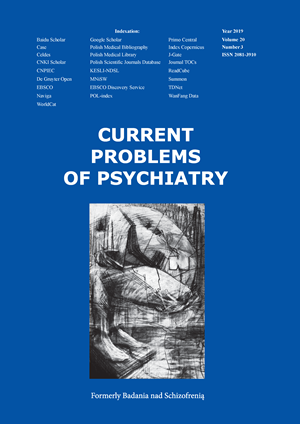Wendigo psychosis
DOI:
https://doi.org/10.2478/cpp-2019-0014Keywords:
Wendigo psychosis, cannibalism, culture-bound syndromesAbstract
Introduction. Wendigo psychosis is considered an endemic psychiatric disorder associated with culture. It manifests through compulsive, strong attacks of cannibalistic behaviors. It mainly concerns Algonquian. Cree tribes and people living in the Northern Ojibwa area.
Material and methods. In our article, we have collected available publications on Wendigo's psychosis. This area included Internet databases: PubMed and Google Scholar, from the first reports on the disease to the latest information. Due to culturebound syndromes and the rarity of occurrence in the present time at work, we focused not only on symptoms, treatment or diagnosis, but also on historical and ethnographic features.
Discussion. The first remarks on this disorder derive from the Powhatan dictionary which was used by the Algonquian tribe. In the 1960s there were 70 cases of the disease, but the available epidemiologic data is poor. There are many legends about the mythical creature Wendigo and its likeness is repeatedly used in popular culture. Most of the symptoms exhibited by those suffering from this dysfunction is related to famine and chronic loneliness, e.g. apathy, neurosis.
Summary. The treatment of the psychosis in the past was based on folk beliefs, as well as homicide. Modern medicine offers a wide spectrum of antipsychotic drugs whose use is focused on the elimination of side effects. Pharmacotherapy consists in administering to the sick drugs from the group of benzodiazepines or antipsychotic agents of both the first and the second generation.
References
1. Horn, Kahntineta (March 14, 2013). "Boogie Men". mohawknationnews.com. Kahnawake: Mohawk Nation News. Retrieved August 24, 2018.
2. Brightman, Robert A. (1988). "The Windigo in the Material World" (PDF). Ethnohistory. 35 (4): 337-379. doi:10.2307/482140. JSTOR 482140.
3. Marano, L. (1982). Windigo psychosis: The anatomy of an emicetic confusion. Current Anthropology, 23(4), 385-412.
4. Rohrl, V. J. (1970). A nutritional factor in windigo psychosis. American Anthropologist, 72(1), 97-101.
5. Friedman, C.T.H. (1982). The so called hysteropsychoses: Latah, windigo and pibloktoq. In Extraordinary Disorders of Human Behavior
6. https://analepsis.files.wordpress.com/2015/02/windigo2.pdf
7. Lietz, M. (2016). Cannibalism in contact narratives and the evolution of the wendigo.
8. https://www.dictionary.com/browse/browser
9. Fiddler, Thomas; Stevens, James R. (1985). Killing the Shamen. Manotick, Ontario: Penumbra Press. ISBN 978-0920806814
10. Leighton AH, Hughes JM PhD. Cultures as a Causative of Mental Disorder. Milbank Q. 2005;83(4): 10.1111/j.1468-0009.2005.00424.x.
11. Peter J. Guarnaccia , Ph.D., and Lloyd H. Rogler , Ph.D. 1999. Research on Culture-Bound Syndromes: New Directions, The American Journal of Psychiatry
12. Miller, Shelby (2016) "Sudden and Entire": Investigating the Accusation of Cannibalism in the Early Chippewa Tribes. History 489: Research Seminar
13. D. Semple, R. Smyth, J. Burns, R. Darjee, A. McIntosh 2007. Oksfordzki podręcznik psychiatrii. Redaktor Naukowy wydania polskiego prof. dr hab. n. med. Anna Grzywa. Copyright Oxford University Press. Wydanie I Lublin 2007, s. 198. Wydawnictwo Czelej, ISBN 978-83-60608-12-8.
14. Hay, T. H. (1971). The Windigo Psychosis: Psychodynamic, Cultural, and Social Factors in Aberrant Behavior 1. American anthropologist, 73(1), 1-19.
15. Leahy, R. The Devils of Cultural Conflict in Louise Erdrich’s “Saint Marie”.
16. Murphy, B. P., & Brewer, W. J. (2011). Early intervention in psychosis: clinical aspects of treatment. Advances in psychiatric treatment, 17(6), 408-416.
Downloads
Published
Issue
Section
License
Copyright (c) 2019 Authors

This work is licensed under a Creative Commons Attribution-NonCommercial-NoDerivatives 3.0 Unported License.


